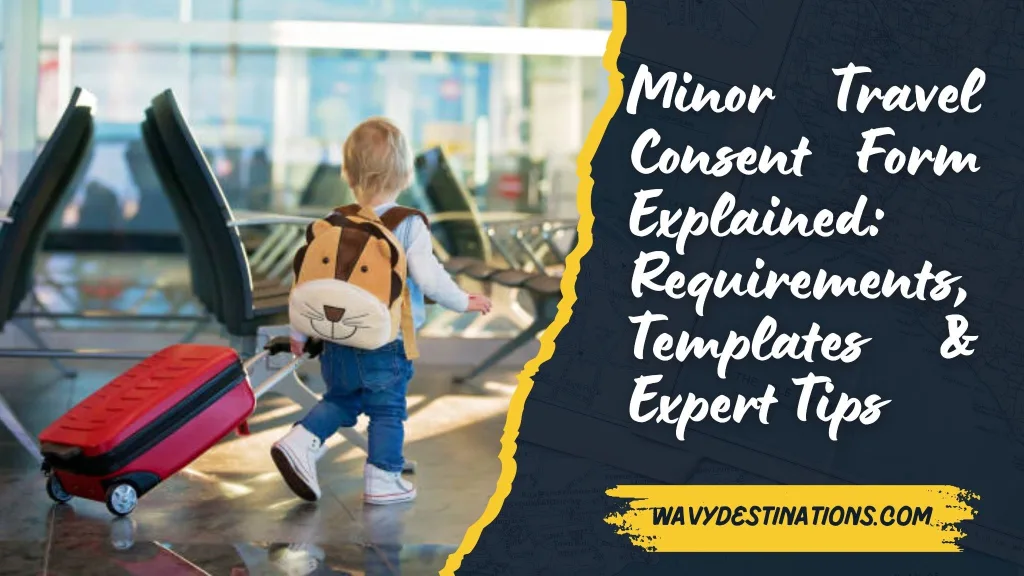Minor Travel Consent Form Explained: Requirements, Templates & Expert Tips
When my child was invited to join a school trip abroad last year, I didn’t realize how much paperwork was involved. I had packed his clothes and passport, but when the travel agent mentioned a minor travel consent form, I froze.
Until then, I had no idea this simple piece of paper could make or break a child’s travel plans. After a week of research, phone calls, and even a trip to a notary’s office, I finally understood how essential this document is and how it keeps kids safe when traveling alone or with someone else.
In this guide, I’ll walk you through everything I learned, from the purpose of the form to how to fill it out correctly for different travel situations, including flights with Delta, cruises, and international trips to the UK and Canada

What Is a Minor Travel Consent Form?
A Minor (Child) Travel Consent Form is a legal document that permits for a child to travel alone, or with another adult who isn’t their parent or legal guardian.
It’s typically signed by one or both parents and may be notarized to verify authenticity. This consent proves to border authorities, airlines, and cruise lines that the child’s travel has been approved by their guardians preventing issues like custody disputes or child abduction concerns.
I like to think of it as my child’s “travel permission slip”, only this one is international and has legal weight.
When Do You Need a Minor Travel Consent Form?
I learned quickly that a travel consent form isn’t just for solo flyers. There are several situations where authorities or airlines will ask for it:
- When a child travels with one parent (especially if parents are divorced or separated)
- When a child travels with grandparents, teachers, or family friends
- When a child travels alone as an unaccompanied minor
- When traveling internationally, especially across borders like the U.S.–Canada or U.S.–U.K. routes
Even on domestic flights, some airlines such as Delta require this document for minors under certain age groups. It’s always safer to have one prepared.
My Experience with Airline Requirements (Especially Delta)
When I booked my son’s flight with Delta Air Lines, I discovered their Unaccompanied Minor Program had strict rules:
- Under 5 years old: Cannot fly alone (must travel with someone at least 18).
- Ages 5–11: Can travel alone, but only on nonstop flights.
- Ages 12–14: Can travel with or without the unaccompanied minor service.
- 15+ years old: No consent form required, though still recommended for international travel.
Delta asked me to fill out both their unaccompanied minor form and a Minor Travel Consent Form. The staff suggested I get it notarized, especially since my child would be leaving the country.

Pro Tip: Always carry two copies, one for your child and one for the airline or border control officer.
What the Minor Travel Consent Form Includes (Step-by-Step)?
When I sat down to complete the form, I realized it’s quite straightforward. Here’s what most versions include:
- Parent or Guardian Information: Full names, addresses, and contact numbers of the custodial parent(s).
- Child’s Details: Name, date of birth, place of birth, and passport information.
- Travel Details: Destination, travel dates, flight or cruise info, and who the child is traveling with.
- Accompanying Person’s Info: If applicable, include their name, relationship, and ID or passport number.
- Signatures: Of both parents or legal guardians, signed and dated.
- Notarization (Optional but Recommended): Adds a layer of legal verification, especially for international trips.
Minor Travel Consent Form for Cruises
When we took a family cruise to the Caribbean, the cruise line also required a minor travel consent form since my sister (not my child’s legal guardian) was listed as the primary adult on the booking.

Cruise Tip: Always bring a copy of your child’s birth certificate and passport along with the consent form.
🇬🇧 Traveling to the UK or 🇨🇦 Canada with a Minor
While researching, I found that both the UK and Canada have specific entry requirements for minors traveling without both parents.
For the UK
If your child travels to the UK alone or with one parent:
- They must carry a notarized letter of consent signed by both parents.
- The letter should include the name of the accompanying adult, the travel dates, and contact information for both parents.
For Canada
The Government of Canada recommends:
- A written consent letter, ideally notarized and in English or French.
- It should clearly state who the child is traveling with, where they’re going, and for how long.
- If one parent has sole custody, include a copy of the custody document.
I remember carrying both documents in a folder marked “Travel Authorization.” The border officer appreciated how organized it was and let us through quickly.
Free Minor Travel Consent Form Template
Many online platforms offer free downloadable templates. I personally used one from a legal document website, then customized it with our travel details.
A basic free child travel consent form should include:
- Full child and parent details
- Itinerary and destination info
- Signatures from both parents
- A notary’s seal if required

You can create it easily using free tools like LawDepot or eForms, then print and sign it.
Why Notarization Matters?
Even though notarization isn’t always required, I found that having it notarized made everything smoother, especially at customs.
A notary public verifies your identity and witness signatures. Their seal tells border officers that the consent is authentic and trustworthy.
For international travel, this small extra step is worth the peace of mind.
Common Mistakes Parents Make (and How I Avoided Them)
When I was preparing my form, I came across so many stories of parents being delayed at airports due to small oversights. Here’s what I learned to watch out for:
- Forgetting to include travel dates or destination details: authorities may reject incomplete forms.
- Not listing the accompanying adult’s full information: always add their ID/passport number.
- Skipping notarization for international travel: better safe than sorry!
- Not packing copies: carry both physical and digital copies in your email or phone.
- Assuming domestic travel doesn’t need consent, some airlines still require it, even within the U.S.
How Early Should You Prepare It?
I recommend preparing the form at least two weeks before the trip. This gives you time to:
- Verify requirements with the airline or cruise line.
- Get the form notarized.
- Make multiple copies for your child, their companion, and airport officials.
If traveling abroad, check both the departure and destination country’s regulations.
Frequently Asked Questions
Do both parents need to sign the consent form?
Yes, ideally both parents should sign, especially for international travel. This helps avoid any legal or border issues. If one parent has sole custody, include a certified copy of the custody agreement for verification.
Can I use the same form for multiple trips?
It’s best to create a new form for every trip since travel details like destination and dates change. Having updated information ensures smoother verification by airlines and border officials, minimizing any potential delays or misunderstandings during travel.
What if my child travels frequently?
If your child travels often, you can prepare a general consent form valid for six months or one year. However, always confirm with your airline, cruise line, or border authority whether they accept long-term travel consent forms for minors.
Is a minor travel consent form required for cruises?
Yes, it’s required when a child travels without both parents or with another adult. Cruise lines enforce this rule strictly to prevent unauthorized travel and ensure safety, especially for international voyages that cross multiple ports or countries.
Can I get a minor travel consent form in Canada or the UK?
Absolutely. Both Canada and the UK provide downloadable templates on government and legal websites. These official templates follow local travel regulations, ensuring your document meets all required standards for domestic and international travel with minors.
Final Thoughts: Why Every Parent Should Prepare One
After going through the process myself, I realized that a minor travel consent form isn’t just paperwork — it’s peace of mind. It ensures your child can travel safely, and it proves to airlines and authorities that everything is in order.
If you’re like me, you’ll want to make travel as smooth and stress-free as possible for your child. Spend those extra few minutes filling out the form, getting it notarized, and organizing the documents — because once you’re at the airport, you’ll be so glad you did.






